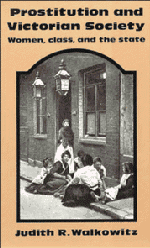Book contents
- Frontmatter
- Contents
- Preface
- Introduction: The Revolt of the Women
- Part I Prostitution, Social Science, and Venereal Disease
- Part II The Contagious Diseases Acts, Regulationists, and Repealers
- 4 The Contagious Diseases Acts and Their Advocates
- 5 The Repeal Campaign
- 6 The Leadership of the Ladies' National Association
- 7 Class and Gender Conflict Within the Repeal Movement
- Part III Two Case Studies: Plymouth and Southampton Under the Contagious Diseases Acts
- Epilog
- Notes
- Selected Bibliography
- Index
7 - Class and Gender Conflict Within the Repeal Movement
Published online by Cambridge University Press: 01 June 2011
- Frontmatter
- Contents
- Preface
- Introduction: The Revolt of the Women
- Part I Prostitution, Social Science, and Venereal Disease
- Part II The Contagious Diseases Acts, Regulationists, and Repealers
- 4 The Contagious Diseases Acts and Their Advocates
- 5 The Repeal Campaign
- 6 The Leadership of the Ladies' National Association
- 7 Class and Gender Conflict Within the Repeal Movement
- Part III Two Case Studies: Plymouth and Southampton Under the Contagious Diseases Acts
- Epilog
- Notes
- Selected Bibliography
- Index
Summary
The aggressive feminism of LNA leaders inevitably brought them into conflict with some male repealers. Although a number of men in the campaign shared the feminist and libertarian sentiments of the LNA leadership, they tended to be concentrated in the politically ineffective National Association. As Josephine Butler frequently complained in her letters, the London-based National Association focused too narrowly on parliamentary lobbying and left popular agitation to others. Instead, the LNA had to look to northern industrialists like Henry J. Wilson and Edward Backhouse for money and support. Although tireless in their efforts, provincial leaders like Wilson had little sympathy for the personal-rights libertarian concerns of the LNA. The LNA leadership, then, found itself bound to two unsatisfactory middle-class allies: the “do nothings” of the National Association, who were nonetheless ideologically correct on most feminist issues, and the “goody goodies” of the provincial electoral leagues, who, while often antifeminist, could be counted on to assume active political roles in support of repeal.
As a consequence, feminist repealers felt obliged to wage a woman's battle on two fronts. In public, LNA leaders fought for the right of women to control their own persons against the arbitrary control of police and doctors. In private, they fought for their own political rights and authority within the repeal movement. Political differences with middle-class leaders forced them to enter into an interclass alliance with workingmen and more generally to identify a special mission for themselves within the repeal camp.
- Type
- Chapter
- Information
- Prostitution and Victorian SocietyWomen, Class, and the State, pp. 137 - 148Publisher: Cambridge University PressPrint publication year: 1980

